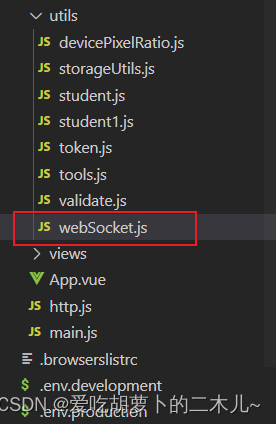vue中websocket的使用---详解
一、什么是webscoket
WebSockets 是一种先进的技术,它可以在用户的浏览器和服务器之间打开交互式通信会话。使用此 API,可以向服务器发送消息并接收事件驱动的响应,而无需通过轮询服务器的方式以获得响应。
WebSockets 这种技术中有一个接口名为WebSocket,它是一个用于连接 WebSocket 服务器的主要接口,之后可以在这个连接上发送和接受数据。接下来的案例则是使用该接口创建一个WebSocket对象来进行管理。
二、创建对象
使用WebSocket接口创建对象,在创建对象之前,判断当前使用的浏览器是否支持该技术,不支持则无法进行一下步操作。
使用WebSocket接口中的构造器创建对象,构造器中传入要连接的 URL,也就是WebSocket 服务器将响应的 URL。其中ws表示使用的是WebSocket协议;还有一种wss相较于ws更为安全,他们类似于http和https。
if ("WebSocket" in window) {
const resRole = await getUserInfo();
//这里对路径进行了配置,关于.env请看上一篇文章
const wsUrl = process.env.VUE_APP_WEBSOCKET_API + `userCount/${resRole.user.userName}`;
socket = new WebSocket(wsUrl);
//上面两行等价于
socket = new WebSocket("ws://localhost:8080/webSocketServer"); //直接写路径
} else {
Notification.error({
title: "错误",
message: "您的浏览器不支持websocket,请更换Chrome或者Firefox",
});
}三、处理事件
在上面对象创建成功的基础上,就可以使用该对象的处理事件了,主要分为以下四种:
| 事件 | 事件监听器 | 描述 |
| open | webSocket.onopen | 用于指定链接成功后的回调函数 |
| message | webSocket.onmessage | 用于指定当从服务器接受到信息时的回调函数 |
| error | webSocket.onerror | 用于指定连接失败后的回调函数 |
| close | webSocket.onclose | 用于指定链接关闭后的回调函数 |
四、webSocket基本已经了解,废话不多说直接上完整代码(我写了个js文件)

import { Notification } from "element-ui";
import { getToken } from "../utils/token";
var socket = null;//实例对象
var lockReconnect = false; //是否真正建立连接
var timeout = 20 * 1000; //20秒一次心跳
var timeoutObj = null; //心跳倒计时
var serverTimeoutObj = null; //服务心跳倒计时
var timeoutnum = null; //断开 重连倒计时
const initWebSocket = async () => {
if ("WebSocket" in window) {
const wsUrl = '链接地址';
socket = new WebSocket(wsUrl);
socket.onerror = webSocketOnError;
socket.onmessage = webSocketOnMessage;
socket.onclose = closeWebsocket;
socket.onopen = openWebsocket;
} else {
Notification.error({
title: "错误",
message: "您的浏览器不支持websocket,请更换Chrome或者Firefox",
});
}
}
//建立连接
const openWebsocket = (e) => {
start();
}
const start = ()=> {
//开启心跳
timeoutObj && clearTimeout(timeoutObj);
serverTimeoutObj && clearTimeout(serverTimeoutObj);
timeoutObj = setTimeout(function() {
//这里发送一个心跳,后端收到后,返回一个心跳消息
if (socket.readyState == 1) {
//如果连接正常
// socket.send("heartbeat");
} else {
//否则重连
reconnect();
}
serverTimeoutObj = setTimeout(function() {
//超时关闭
socket.close();
}, timeout);
}, timeout);
}
//重新连接
const reconnect =() => {
if (lockReconnect) {
return;
}
lockReconnect = true;
//没连接上会一直重连,设置延迟避免请求过多
timeoutnum && clearTimeout(timeoutnum);
timeoutnum = setTimeout(function() {
//新连接
initWebSocket();
lockReconnect = false;
}, 1000);
}
//重置心跳
const reset =() => {
//清除时间
clearTimeout(timeoutObj);
clearTimeout(serverTimeoutObj);
//重启心跳
start();
}
const sendWebsocket =(e) =>{
// socket.send(`我发消息了`);
}
const webSocketOnError =(e) => {
initWebSocket();
reconnect();
}
//服务器返回的数据
const webSocketOnMessage=(e) => {
//判断是否登录
if (getToken()) {
//window自定义事件[下面有说明]
window.dispatchEvent(
new CustomEvent("onmessageWS", {
detail: {
data: JSON.parse(e?.data),
},
})
);
}
reset();
}
const closeWebsocket=(e) => {
reconnect();
}
//断开连接
const close =() => {
//WebSocket对象也有发送和关闭的两个方法,只需要在自定义方法中分别调用send()和close()即可实现。
socket.close();
}
//具体问题具体分析,把需要用到的方法暴露出去
export default { initWebSocket, sendWebsocket, webSocketOnMessage, close };window自定义事件
//定义
window.dispatchEvent(new CustomEvent("事件名", {参数key:参数value}))
//监听
window.addEventListener("事件名", 参数key => {})
五、在main.js中挂载到vue原型上
import websocket from './utils/webSocket';
Vue.prototype.$websocket = websocket;六、在需要建立连接的组件中这样写
async mounted() {
this.initWebSocket();
},
methods: {
async initWebSocket() {
this.$websocket.initWebSocket();
},
},七、在需要从服务器获取的数据进行操作的组件中这样写
mounted() {
window.addEventListener("onmessageWS", this.getSocketData);
},
methods: {
getSocketData(res) {
this.PieValue = Number(res.detail.data.sendInfoStr.onlineUserCount);
this.userNumValue = Number(res.detail.data.sendInfoStr.totalUserCount);
},八、在需要关闭连接的组件(比如退出时需要关闭)中这样写
//退出登录
logOut() {
this.$confirm("确定要退出登录吗?", "提示", {
confirmButtonText: "确定",
cancelButtonText: "取消",
type: "warning",
})
.then(() => {
this.$message({
type: "success",
message: "退出成功!",
});
this.$websocket.close();
localStorage.removeItem("token");
this.$router.push("/login");
}).catch(() => {
this.$message({
type: "info",
message: "已取消退出",
});
});
},九、除了按钮可以主动关闭WebSocket连接以外,直接关闭浏览器窗口也会关闭连接,故此需要一个窗口监听器,来防止连接还没断开就关闭窗口,服务端出现异常。
//监听窗口关闭事件,当窗口关闭时,主动去关闭websocket连接
window.onbeforeunload = function () {
this.$websocket.close();
}



 浙公网安备 33010602011771号
浙公网安备 33010602011771号